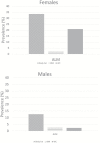Low Lean Mass With and Without Obesity, and Mortality: Results From the 1999-2004 National Health and Nutrition Examination Survey
- PMID: 28207042
- PMCID: PMC5861857
- DOI: 10.1093/gerona/glx002
Low Lean Mass With and Without Obesity, and Mortality: Results From the 1999-2004 National Health and Nutrition Examination Survey
Abstract
Background: The Foundation for the NIH Sarcopenia Project validated cutpoints for appendicular lean mass. We ascertained the relationship between low lean mass (LLM), obesity, and mortality and identified predictors in this subgroup.
Methods: A total of 4,984 subjects aged 60 years and older were identified from the National Health and Nutrition Examination Survey 1999-2004 linked to the National Death Index. LLM was defined using reduced appendicular lean mass (men < 19.75 kg; females < 15.02 kg). Obesity was defined using dual-energy x-ray absorptiometry body fat (males ≥ 25%; females ≥ 35%). LLM with obesity was defined using criteria for both LLM and obesity. Proportional hazard models determined mortality risk for LLM and LLM with obesity, separately (referent = no LLM and no LLM with obesity, respectively).
Results: Mean age was 71.1 ± 0.19 years (56.5% female). Median follow-up was 102 months (interquartile range: 78, 124) with 1,901 deaths (35.0%). Prevalence of LLM with obesity was 33.5% in females and 12.6% in males. In those with LLM, overall mortality risk was 1.49 (1.27, 1.73) in males and 1.19 (1.02, 1.40) in females. Mortality risk in LLM with obesity was 1.31 (1.11, 1.55) and 0.99 (0.85, 1.16) in males and females, respectively. Age, diabetes, history of stroke, congestive heart failure, cancer, and kidney disease were predictive of death.
Conclusions: Risk of death is higher in subjects with LLM than with LLM and obesity. Having advanced age, diabetes, stroke, heart failure, cancer, and renal disease predict a worse prognosis in both classifications.
Keywords: Epidemiology; Low lean mass; Survival.
© The Author 2017. Published by Oxford University Press on behalf of The Gerontological Society of America. All rights reserved. For permissions, please e-mail: journals.permissions@oup.com.
Figures

References
-
- Batsis JA, Barre LK, Mackenzie TA, Pratt SI, Lopez-Jimenez F, Bartels SJ. Variation in the prevalence of sarcopenia and sarcopenic obesity in older adults associated with different research definitions: dual-energy X-ray absorptiometry data from the National Health and Nutrition Examination Survey 1999–2004. J Am Geriatr Soc. 2013;61:974–980. doi:10.1111/jgs.12260 - PubMed
-
- McLean RR, Shardell MD, Alley DE, et al. Criteria for clinically relevant weakness and low lean mass and their longitudinal association with incident mobility impairment and mortality: the Foundation for the National Institutes of Health (FNIH) Sarcopenia Project. J Gerontol A Biol Sci Med Sci. 2014;69:576–583. doi:10.1093/gerona/glu012 - PMC - PubMed
-
- Woo J, Leung J. Anthropometric cut points for definition of sarcopenia based on incident mobility and physical limitation in older Chinese people. J Gerontol A Biol Sci Med Sci. 2016;71:935–940. doi:10.1093/gerona/glv197 - PubMed
MeSH terms
Grants and funding
LinkOut - more resources
Full Text Sources
Other Literature Sources
Medical

